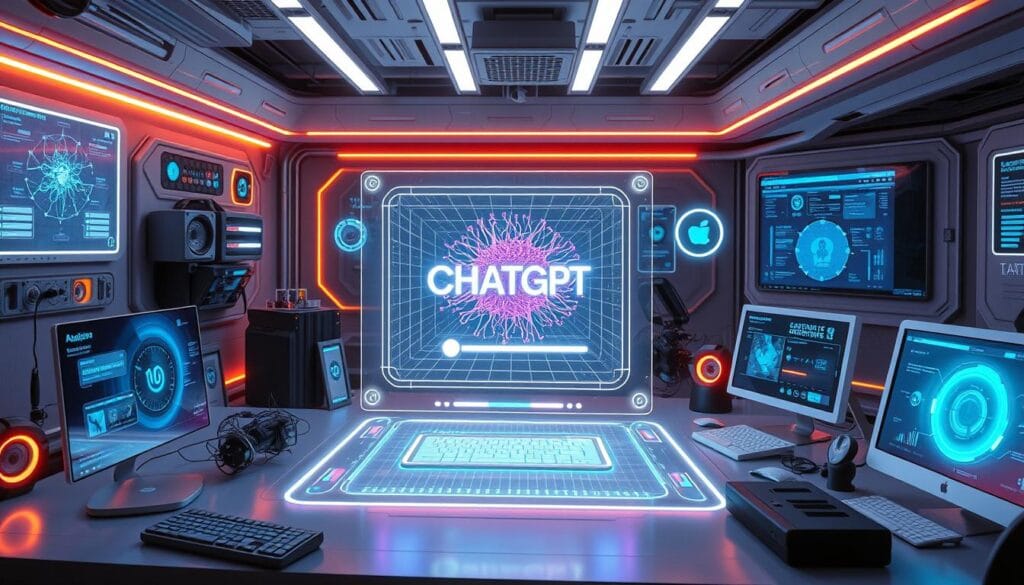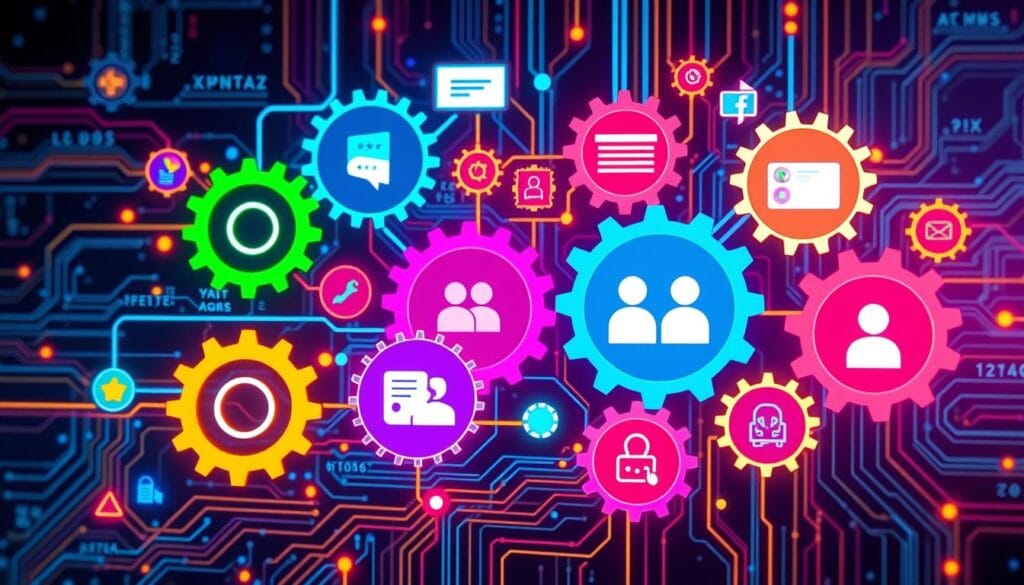“The greatest danger in times of turbulence is not the turbulence; it is to act with yesterday’s logic.” – Peter Drucker. The need to personalize AI language models, like ChatGPT, has never been more urgent. To train ChatGPT to mirror our speech, we must delve into the complexities of language models and the importance of personalization. This article will offer practical advice on customizing AI language models, ensuring chatbot responses are tailored, and making interactions feel genuine.
Large language models (LLMs) need precise and thoughtful prompts to produce the desired content. Effective training requires substantial examples that reflect our unique styles and contexts1. It’s recommended to provide at least three examples, totaling a minimum of 1000 words, to achieve customized outputs. Additionally, using clear instructions and politeness in prompts can guide ChatGPT toward more accurate, contextually relevant, and engaging responses23.
Key Takeaways
- Personalizing ChatGPT enhances user interaction and engagement.
- Providing diverse writing samples improves the model’s understanding of an individual’s voice.
- Utilizing specific and clear instructions can help override generic responses.
- Regular updates and continuous training are essential for maintaining effectiveness.
- Training requires a long-term investment in data collection and refinement.
Understanding ChatGPT’s Language Model
ChatGPT is a cutting-edge language model developed by OpenAI, aimed at natural language processing. It uses extensive datasets for artificial intelligence training, allowing it to converse like a human. By 2024, 43% of college students and 80% of Fortune 500 companies have adopted ChatGPT for their daily tasks4. This widespread adoption highlights the increasing need for advanced AI communication tools.
What is ChatGPT?
ChatGPT is a leading natural language processing tool that employs machine learning to generate text. It processes vast amounts of data to create responses that aim for coherence and relevance. The model’s effectiveness is heavily influenced by the diversity and quantity of content samples during training4. It also benefits from user interactions and feedback, demonstrating its adaptability across various scenarios.
How does it work?
ChatGPT operates through complex algorithms that analyze input data and generate customized responses. The complexity of the user’s writing style significantly impacts training duration, as it determines how quickly the model can replicate that style4. The model retains roughly the last 3000 words to ensure conversation coherence and can adopt specific roles if instructed, leading to more personalized responses5.
Key features of ChatGPT
ChatGPT excels in conversational abilities, capable of assuming various personas or roles, from fictional characters to industry professionals5. Its performance can be enhanced through prompt engineering, which involves refining user inputs to improve responses. Continuous fine-tuning is crucial for achieving desired outcomes, requiring multiple iterations and consistent feedback65.
Importance of Personalization

The importance of tailoring AI interactions cannot be overstated. Personalizing ChatGPT enhances engagement and fosters meaningful communications. It’s crucial for businesses aiming to create effective user experiences in the digital world.
Why personalize ChatGPT?
Personalizing ChatGPT makes it resonate more with users’ preferences and styles. Many health professionals are excited about using ChatGPT to streamline content creation. However, they also worry about losing their unique brand voice7.
Customizing the AI language model ensures communication that aligns with individual or brand specifications. This leads to personalized chatbot responses that feel more human and relatable. By integrating user-specific data, ChatGPT can reflect a user’s voice, core values, and messaging. This is essential for establishing a genuine connection8.
Benefits of customized interactions
Customized interactions offer numerous benefits. They increase efficiency by understanding users’ communication style and context8. This approach not only boosts user satisfaction but also enhances the overall experience.
Conversations become more relevant and engaging. Moreover, personalized approaches can significantly scale customer interactions. They maintain a consistent personal touch in communications8.
Preparing for Custom Training
Preparing for training starts with identifying your unique communication style. This is crucial for effective interactions with AI, especially ChatGPT. Knowing how to express your personal nuances greatly enhances personalization.
Identifying your unique communication style
To effectively identify communication style, reflect on past communications. Look at word choice, sentence structure, and tone. These patterns reveal your style, essential for tailoring ChatGPT’s responses to your preferences.
Collecting relevant data and examples
Gathering relevant data is key in this phase. Compile examples of past communications, like emails and reports. This relevant data collection helps train the model to reflect your voice. Insights from these materials improve ChatGPT’s ability to mimic your style and intent, enhancing interactions.
Creating a Training Dataset

To train ChatGPT effectively, a comprehensive creating training dataset is essential. The dataset should encompass various types of data, ensuring the model learns from diverse examples. These examples can include blogs, social media posts, and email communications. High-quality inputs are crucial for achieving a model that can genuinely emulate a personal communication style or business tone.
Types of data to include
In establishing a training dataset, incorporating well-curated sets of company emails, internal reports, and social media interactions can significantly enhance the model’s performance. The richness of the dataset influences the capabilities of the AI model substantially. Training on over 300 billion words from diverse sources like articles and websites has shown remarkable outcomes, further emphasizing the need for varied examples in dataset collection practices9. Understanding the subject matter and its context is critical, as it creates a solid foundation for effective training.
Best practices for dataset collection
When collecting data, prioritize quality over quantity. Studies indicate that uploading 25 high-quality documents yields more effective training than 250 unrelated or low-quality ones9. This approach allows for a manageable yet powerful dataset that aligns with best practices in dataset collection practices. Regularly test the training data by querying specific aspects to gauge the effectiveness of the learning process. Such methodologies are vital for maintaining relevance and accuracy in responses during real-time interactions.
Formatting your data for ease of use
Proper data formatting is paramount in ensuring that the dataset is easy to navigate and utilizes its full potential. Structuring training data can be compared to organizing a library, where coherence and accessibility are key to generating human-like responses10. Outdated or off-topic information should be systematically removed to maintain the accuracy of the AI’s output. By refining training files regularly, one can enhance the model’s performance and adaptability over time9.
Training ChatGPT with Your Voice
Integrating personal nuances into ChatGPT’s responses can significantly enhance communication. By utilizing OpenAI’s fine-tuning options, users can shape the AI’s output to reflect their unique style. This process relies on the understanding that ChatGPT performs best with clear guidelines and ample input training data.
Utilizing OpenAI’s fine-tuning options
The first step in training ChatGPT involves setting up its fine-tuning options for customization. Users should start by submitting training data that showcases their writing style. This is because the AI excels at discerning unique language patterns from examples. Offering three to seven excerpts of previous work can greatly improve the AI’s ability to mimic a specific voice effectively11.
While this method boosts ChatGPT’s human-like text generation, it’s important to note its limitations. The AI may find it challenging to grasp humor or perfectly replicate certain tones12.
How to input your training data
After setting the fine-tuning options, the next step is to input the training data correctly. Users should share clear examples and specific instructions on the desired tone of voice. This data serves as a foundational element for ChatGPT to generate relevant content.
To maximize the effectiveness of this input, individuals are advised to provide facts, figures, and structured arguments for the AI to incorporate11. Feedback is essential throughout the process. Responses generated by ChatGPT should be closely analyzed, allowing users to make adjustments as needed. This ensures the AI better aligns with their communication style.
Regular updates to the training data are necessary, as the AI does not retain information between sessions. Users must refer back to earlier training for context12.
Testing Your Customized Model

After setting up a customized ChatGPT model, thorough testing is essential to ensure its effectiveness. Testing techniques help fine-tune the model, making it better at responding in a way that mirrors the user’s language style. A mix of quantitative and qualitative methods is key to evaluating these capabilities.
Techniques for effective testing
Start by conducting controlled conversations with specific prompts to assess the model’s responsiveness and consistency. Varying the context lengths and styles is crucial to see how well the model captures the user’s voice. It’s important to monitor the parameters tested to guide adjustments and improvements.
Focus on consistency in tone, vocabulary, and overall coherence in responses. These tests aim to ensure the model meets the user’s expectations for personalized communication.
Evaluating language similarity
Evaluating language similarity is vital to gauge how well the custom model matches the user’s communication style. Metrics like cosine similarity or Jaccard index can quantify the similarity between the AI’s outputs and the user’s language. User feedback also offers valuable insights into the model’s performance and accuracy.
Users often note that the model may lose track of important information after a certain token limit in conversations. This highlights the need for ongoing evaluations to improve performance1314.
Refining ChatGPT’s Responses

Improving ChatGPT’s responses requires a strategic approach. A 3-stage workflow helps users fine-tune the AI’s output. This involves clear instructions and detailed examples for effective training15. Continuous feedback integration is key, allowing for adjustments based on user interactions. Studies indicate that with proper guidance, ChatGPT can match 80% to 90% of the user’s writing style, highlighting the potential for tailored adjustments16.
Methods for improving accuracy
Enhancing ChatGPT’s accuracy starts with precise prompts. These prompts help generate responses that feel more natural and human-like. Using varied sentence structures and informal language can mimic natural speech, enhancing dialogue17. This approach not only improves responses but also fosters a deeper emotional connection with users. Continuous feedback from users is crucial for the AI’s development, enabling it to refine its responses over time.
Utilizing feedback for adjustments
Feedback integration is a powerful tool for refining responses. Human-in-the-loop editing, where human writers work with AI, is particularly effective. This method ensures coherence and accuracy in outputs. The iterative refinement process, backed by user feedback, is essential for achieving desired outcomes and keeping ChatGPT relevant in conversations1516. This continuous improvement model promotes a proactive use of AI, maximizing personalization in communication.
Enhancing Conversational Context

Understanding the importance of context in conversations is crucial for ensuring that interactions with AI, like ChatGPT, yield coherent and relevant responses. Context-aware responses can make a significant difference in how users perceive and relate to the technology. By carefully guiding ChatGPT with contextual cues, users can improve the quality of interactions and create a more engaging experience.
Importance of context in conversations
Context provides a framework within which conversations take place, influencing both the understanding and delivery of responses. Without adequate context, AI-generated replies may come off as generic or misaligned with user expectations. Enhancing conversational context with specific highlights can create a more meaningful dialogue, ultimately leading to better outcomes for users seeking insightful and tailored interactions with ChatGPT. This shift underscores the necessity for adopting a strategy for context that emphasizes clarity and relevance.
Strategies for providing context to ChatGPT
Implementing effective strategies involves being explicit about the conversational elements needed for context. Modifying prompts to adopt a tone that is conversational and concise can help achieve this goal. For instance, the approach of changing the tone to be “conversational, spartan, and avoiding corporate jargon” allows ChatGPT to generate responses that resonate on a more human level, thereby improving user engagement with the dialogue18. Continuous improvements in AI language models such as ChatGPT suggest ongoing advancements in natural language generation, highlighting the system’s ability to incorporate user feedback in a constructive manner18.
Utilizing External Tools

Choosing the right external tools can significantly enhance the customization of ChatGPT. Many third-party platforms offer innovative solutions that boost the training process. This enables users to develop a version of ChatGPT that reflects their unique communication style. ChatGPT allows users to build multiple custom ChatGPTs, often resulting in increased engagement19. Each user, whether a business or an individual, can leverage various platforms to facilitate the development of distinct writing styles. This enhances their overall experience with AI.
Third-party platforms for customization
Various third-party platforms offer distinct features for tailoring ChatGPT interfaces. For instance, these tools may allow users to toggle between GPT-4o and GPT-4 versions. This accommodates training on expansive writing styles with a capacity of around 50,000 words19. Utilizing natural language for creating GPTs along with uploading knowledge source files streamlines the customization process. It makes it more intuitive and less time-consuming. By amalgamating these platforms with the ChatGPT custom instructions feature, users can gauge various requirements to refine generated responses19.
Benefits of additional tools
The benefits of utilizing these external tools are manifold. They provide enhanced functionality and efficiency, allowing for ongoing experimentation with writing style descriptors and prompts. This results in marked improvements in the quality of content generated by ChatGPT, fostering a better user experience with reduced robotic responses20. The ability to define a consistent style contributes to building trust and engagement with the audience—a significant aspect for both businesses and freelancers20. In essence, training ChatGPT to mimic one’s writing style not only streamlines content creation but also ensures the final output resonates with the author’s authentic voice21.
Ethical Considerations

The advent of AI technologies like ChatGPT brings forth critical ethical concerns. It’s imperative to grasp the biases embedded in training data and their impact on AI outputs. For example, GPT-3 has shown biases in gender, race, and religion, highlighting the need for fairness in AI use22. Moreover, the datasets often favor younger individuals and English speakers, limiting the model’s grasp of diverse viewpoints22.
Responsible use of AI
AI’s responsible use demands awareness of content moderation hurdles. Identifying harmful content, such as sexual or violent material, poses significant challenges22. Ethical dilemmas also stem from AI models relying on underpaid labor for moderation, as seen in Kenya22. Users must be cautious about data privacy, as companies might track interactions for improvement23. OpenAI’s practice of reviewing conversations raises concerns about the confidentiality of sensitive discussions23.
Handling sensitive data
Ensuring the secure handling of sensitive data is crucial for maintaining user trust and adhering to regulations. Users often share personal information with ChatGPT, which can be stored despite OpenAI’s claims of non-retention23. Changes in policies can create ambiguities about data retention and duration23. The ethical implications of emotional support from AI are also significant, as users may develop attachments, complicating its role as a conversational partner23. It’s essential to balance ethical concerns with AI’s capabilities, requiring constant vigilance and a commitment to responsible use.
It is essential that AI stakeholders prioritize ethical frameworks to guide the development and deployment of technology.
Real-world Applications

Customized ChatGPT models show great potential in many real-world uses. They are versatile in both personal and professional areas. These uses improve user experience and increase efficiency in various sectors.
Personal use cases for customized ChatGPT
People can use personalized ChatGPT for many tasks. This includes creating engaging content and getting tailored advice. For instance, ChatGPT can help with writing educational materials in a unique voice.
It also supports personalized learning plans by adapting to individual learning styles. This makes learning more engaging25. Additionally, ChatGPT can assist with travel planning, offering recommendations that match personal preferences. This enhances convenience and enjoyment26.
Business applications of personalized models
Businesses use customized ChatGPT to improve customer interaction and streamline processes. In customer service, ChatGPT efficiently handles multiple inquiries. This boosts response rates and customer satisfaction25.
It also helps legal professionals by analyzing legal documents and providing insights. This aids in research and strategy formulation25. The financial sector benefits too, with ChatGPT offering valuable trading and investment analysis25. These applications optimize workflows and create more interactive, personalized experiences for clients. This enhances brand communication.
Common Challenges and Solutions

Training an AI like ChatGPT comes with several training challenges that can affect its performance. Users often face common issues like getting responses that are not accurate or relevant. Knowing these problems helps in finding effective solutions to improve the training process.
Frequently encountered issues
One major challenge is ChatGPT’s training data cutoff in September 2012. This means its responses may include outdated information, as its database is over 15 months old27. Users might also find the AI’s responses feel too robotic or lack the human touch. This often happens when the prompts don’t clearly define the context, tone, or identity28.
Overcoming obstacles in training
To overcome these training challenges, users should work on improving their prompts. They should include specific details like context and tone. This has been shown to greatly improve the quality and engagement of the AI’s responses. Creating a detailed style guide is also helpful in keeping the AI’s voice consistent which is key for effective communication.
Providing continuous feedback is crucial for the AI to learn and adapt. This helps it overcome its initial limitations29. Testing the model’s outputs in a structured way can reveal areas for improvement. This leads to better solutions as the training progresses.
User Feedback Mechanisms

Gathering user feedback is crucial for improving ChatGPT’s performance. It creates a loop where the model can become more efficient and aligned with user needs. Successful mechanisms allow for effective communication between users and the AI, enhancing interaction quality.
How to gather feedback
One efficient way to gather feedback is through interactive mechanisms like feedback buttons to like or dislike responses, fostering user engagement. A recent analysis found a total of 8 interactions among users in the chat, showcasing a robust mechanism to involve user feedback30. This method enables developers to receive real-time human feedback, refining the model based on users’ preferences30. Implementing such systems ensures that the AI learns from diverse feedback, ultimately leading to enhancements in response accuracy.
Analyzing user responses for improvement
To improve ChatGPT, analyzing user responses is critical. Regularly assessing input allows developers to pinpoint areas needing adjustment based on feedback received30. It emphasizes the significance of reinforcement learning, wherein human feedback plays an essential role in evolving AI capabilities30. A strong feedback analysis framework can help mitigate issues related to negative feedback, which might impact account ratings30. As companies increasingly utilize these feedback mechanisms for better service, ChatGPT can benefit from a more structured approach to user feedback30.
Keeping the Model Updated

Regular updates are crucial for keeping customized models like ChatGPT effective. These updates ensure the model stays in line with current communication trends and user preferences. Given the fast pace of language and user interaction changes, it’s vital to commit to ongoing training strategies.
Importance of regular updates
The need for model updates is clear. AI models’ performance can decline if they don’t adapt to user behavior and language shifts. Users can train their models to mimic their voice by generating hundreds of conversation examples and converting text snippets into a neutral tone31. It’s also advised to have at least 400 samples for fine-tuning to capture the desired style nuances31.
Strategies for ongoing training
Effective ongoing training involves various methods. Custom instructions help users teach ChatGPT their writing styles, while editorial guidelines and original writing samples enhance AI output32. Using the API to generate dialogue samples can also make training easier, especially for those who prefer not to do it manually31. Few-shot training methods, which involve presenting styled and neutralized text pairs, can further improve the model’s abilities33.
Case Studies: Successful Personalization

ChatGPT’s integration in various sectors presents compelling case studies of successful personalization. These examples show how companies use AI to improve user engagement and communication. They transform AI interactions into personalized experiences.
Examples of effective ChatGPT training
Handled, using the HubSpot CRM platform, expanded to 121 locations across 37 states in 18 months. This rapid growth highlights the impact of effective training and customization on operational efficiency and reach34. ServiceBell also integrated live video chat and remote screen takeover, enhancing customer interaction through personalized communication34. By employing AI tools like Sybill, they automated tasks, freeing up their sales team’s time34.
These examples demonstrate AI’s potential in addressing corporate needs and streamlining workflows.
Lessons learned from the field
Creating tailored ChatGPT personas offers significant benefits. This approach allows for more focused responses to customer needs while maintaining brand consistency. Companies that adopted these personas saw a notable increase in user engagement and communication efficiency35.
AI tools also significantly reduce time on repetitive tasks. An online education company cut customer service costs by 83%, saving over 12 hours weekly36. These case studies underscore the need to understand brand voice and customer expectations. They also highlight the value of structured prompts in guiding AI behavior for more effective interactions35.
Conclusion: Embracing AI Personalization
The evolution of AI personalization is transforming communication landscapes. The introduction of AI tools like ChatGPT marks a significant shift. Over 100 million users have adopted ChatGPT in just two months, highlighting a growing need for personalized digital interactions37. Educational bodies, such as the NSW Department of Education, are now exploring AI applications like NSWEduChat to enhance learning. This shows the vast potential of AI in various sectors38.
The future of communication is bright, with generative AI leading the way. It enables interactions that feel almost human. Yet, it’s vital to remember that AI can only enhance, not replace, the human element in building genuine connections39. Users can tailor their AI tools to create more engaging experiences. This personalization ensures interactions meet individual needs.
Adopting personalized AI interactions is more than a trend; it’s a necessary step in improving communication. As these technologies evolve, it’s crucial for both individuals and organizations to explore and innovate. This will ensure that future communication remains impactful and effective for everyone37.
FAQ
What is ChatGPT?
Why is it important to personalize ChatGPT?
How can I identify my unique communication style for training?
What types of data can I include in my training dataset?
How do I input my training data into ChatGPT?
What are effective techniques for testing my customized ChatGPT?
How can I refine ChatGPT’s responses for better accuracy?
Why is context important in conversations with ChatGPT?
What external tools can assist in customizing ChatGPT?
What ethical considerations should I be aware of when training AI?
Can you provide examples of personal use cases for a customized ChatGPT?
What common challenges might I face while training ChatGPT?
How can I effectively gather and analyze user feedback?
Why is it important to keep the ChatGPT model updated?
Are there any successful case studies on ChatGPT personalization?
Source Links
- Train ChatGPT To Write Like You In 5 Easy Steps
- Mastering ChatGPT: The Ultimate Guide to Training AI to Sound Just Like You
- Mastering Your Voice: How to Train ChatGPT to Sound Like You.
- How To Train ChatGPT To Write Like You in 6 Simple Steps
- Unlock the power of ChatGPT with prompt engineering
- 7-Step Process to Get ChatGPT To Write in Your Tone of Voice
- 7 Proven Strategies to Make ChatGPT Sound Like You ✍️
- How to Train Your AI Chatbot with Your Own Data
- How to train ChatGPT with Your Own Data: Comprehensive Guide
- How to Train ChatGPT on Your Own Data to Customize Outcomes
- 7 ChatGPT Prompts To Train AI To Write Like You
- How to make ChatGPT sound like you or any other celebrity
- How to train ChatGPT with your custom data and create your own chatbot
- Customizing a custom GPT. Knowledge persistence
- 2 Steps to Make ChatGPT Speak Like You
- How to Get ChatGPT to Write Like You
- Tips To Make ChatGPT Sound More Like A Human – 9meters
- How I Got ChatGPT To Sound More Human 💀
- How to train ChatGPT to write like you | Zapier
- How to Train Your Own GPTs to Your Unique Voice in Seconds
- How to Train ChatGPT to write like you – It’s That Lady Dev
- Some ethical considerations in ChatGPT and other LLMs – You’re the Teacher
- ChatGPT: Ethics and bias
- Discussing ethics with ChatGPT
- ChatGPT in Action: Real-world Use Cases
- The Best Examples Of What You Can Do With ChatGPT
- The Ultimate Guide for Using ChatGPT for English Learning
- 15+ Rules For Crafting Effective GPT Chat Prompts – #1 Linkedin Automation Tool
- How to Use Chat GPT? A Simple Guide for Beginners
- How does the Feedback really work?
- Train a GPT model in my tone
- How to train ChatGPT to write like you – Intellectual Lead
- Can I train it to write like me? How?
- Create Case Studies with ChatGPT: Prompts and Best Practices
- Your guide to creating successful ChatGPT Personas – neuroflash
- ChatGPT Business Growth 📈 Case Studies
- “Chatting with ChatGPT”: Analyzing the factors influencing users’ intention to Use the Open AI’s ChatGPT using the UTAUT model
- Embracing Generative AI in Education: Can ChatGPT replace the role of teachers in the classroom?
- My conversation with ChatGPT about its trustworthiness







